As a proud Texan and seafood lover I look forward to Texas shrimp season each year. Our Gulf Coast offers some of the best and most abundant shrimp around. However shrimp populations fluctuate throughout the year, which is why Texas has set shrimping seasons to ensure sustainability of this incredible local resource.
In this guide, I’ll explain everything you need to know about Texas shrimp seasons for both recreational and commercial shrimping. Whether you are an angler or just love eating fresh Gulf shrimp, understanding the shrimp seasons will help you get the most out of one of Texas’ most beloved and delicious natural treasures.
Overview of Texas Shrimp Seasons
The state of Texas carefully regulates shrimping seasons in bays, Gulf waters and federal waters to allow shrimp populations to replenish and thrive. Different rules apply depending on whether you are recreational or commercial shrimping.
Here’s a quick overview of the seasons:
Recreational
- Year-round for bait shrimp with limits
- Spring season May 15 – July 15
- Fall season August 15 – November 30
- Limited to cast nets and baited trotlines only
Commercial
- Closed May 15 – July 15 in all waters
- Open season August 15 – November 30 based on annual sampling
- Additional seasonal closures and restrictions apply
Now let’s take a deeper dive into the details on recreational and commercial seasons, regulations and more.
Recreational Shrimping Seasons
For recreational shrimpers in Texas, here are the seasons and rules to know:
Bait Shrimping
- Open year-round
- Limit of 2 quarts per person with heads on
- Allowed gear: dip net, minnow seine, bait shrimp trawl
Spring Open Season
- May 15 – July 15
- Cast net or baited trotline only
- Daily limit 15 pounds per person
Fall Open Season
- August 15 – November 30
- Cast net or baited trotline only
- Daily limit 15 pounds per person
Texas provides generous seasonal opportunities for anglers to shrimp recreationally and stock up on fresh bait shrimp. Be sure to review size limits, gear restrictions and other regulations to stay compliant.
Commercial Shrimping Seasons
For commercial shrimpers seeking large harvests for sale and distribution, the seasons and regulations get a bit more complex. Here are some key points on commercial seasons:
-
Closed season May 15 – July 15 inside bays and up to 200 nautical miles offshore
-
Typically opens August 15 but opening date varies annually based on sampling results
-
Inside waters and Gulf waters out to 9 nautical miles close when quota met
-
Federal waters from 9-200 miles remain open year round
-
Seasonal area closures once quota reached
-
Harvest restricted to specific shrimp sizes based on location
As you can see, commercial shrimpers must adhere to strict seasons and Adaptive management based on scientific shrimp population data. This ensures a healthy ongoing population and ecosystem despite intensive harvests.
How Are Texas Shrimp Seasons Determined?
You may be wondering how Texas determines the specifics around shrimp season openings and closures each year. It’s actually a scientific process based on sampling shrimp populations.
-
Biologists conduct offshore surveys before seasons open.
-
They assess size, number, and species of shrimp in Gulf and bay areas.
-
Data determines if shrimp have reached optimal maturity and abundance for harvest.
-
Findings are presented to an expert committee who makes final recommendations to TPWD.
-
Season dates and closure requirements are adjusted accordingly.
By basing seasons on hard population data, Texas provides ample harvesting opportunities while still protecting and conserving shrimp as a sustainable fishery.
Why Do Shrimp Seasons Vary?
While Texas shrimp populations are robust overall, there are naturally occurring factors that cause fluctuation and require seasons to vary year to year:
-
Spawning cycles – Shrimp reproduction follows biological cycles. Seasons target peak spawning and maturity.
-
Water temperature – Shrimp growth depends on ideal water conditions. Colder winters can delay maturity.
-
Natural predation – The balance of shrimp and their natural predators impacts populations.
-
Habitat health – Factors like pollution and sedimentation affect shrimp growth habitat.
-
Overfishing – Excess harvesting without regulation can deplete shrimp numbers.
By responding directly to these variables based on sampling, Texas provides flexibility to align shrimping effort with real-time population levels.
When is Peak Shrimp Season in Texas?
The peak shrimp season when both abundance and size are ideal generally falls between August and October. By this time, shrimp have had spring and summer to reach full maturity sizes after the spawning period.
The spring season offers a chance to harvest smaller, younger shrimp. But fall is when you can expect to see the biggest, juiciest Texas shrimp available in their highest numbers.
Within the broad fall season timeline, I find September to be the prime time for Texas shrimp if you are lucky enough to get your hands on fresh caught shrimp right in the heart of peak season.
How to Enjoy Texas Shrimp Season
Here are some of my favorite ways to make the most of Texas shrimp season:
- Book shrimping and fishing trips to catch your own if possible
- Check local restaurants for fresh caught seasonal offerings
- Ask shrimp shops for the freshest fall catches
- Try new shrimp recipes that let the ingredients shine
- Grill, fry, steam or sautée fresh shrimp simply
- Host shrimp boils or bakes for family and friends
- Enjoy shrimp tacos, po’ boys, ceviche, and classic shrimp cocktails
- Pair sweet Texas shrimp with spicy sauces and seasonings
However you choose to partake, be sure to savor shrimp season in Texas. Enjoy shrimp fresh or stock up for later since properly frozen shrimp keep beautifully.
Shrimp Season Contributes to Local Economy
The shrimping industry and seasonal harvests are a vital economic engine for the Texas Gulf Coast. Some key benefits include:
-
Provides seasonal jobs and income to thousands of Texans
-
Generates business for ports, processors, distributors and retail
-
Supplies restaurants and grocery stores with locally caught seafood
-
Shrimping culture and heritage attract tourism dollars
By supporting responsible shrimping practices, we can preserve this vital local tradition and industry for generations to come.
Obeying Shrimp Season Rules
As a passionate Texan angler and seafood lover, I always make sure to know and follow the letter of the law when it comes to shrimp season regulations. The future of our precious shrimp fishery depends on compliance from recreational and commercial harvesters alike.
My tips for staying on the right side of Texas shrimp season rules include:
-
Checking TPWD website for updates before each season
-
Knowing exact season dates, legal harvesting gear and catch limits
-
Measuring shrimp catch carefully to avoid overlimits
-
Following area-specific closures once quotas are reached
-
Reporting violations to TPWD enforcement hotline
We all must do our part to ensure bountiful Texas shrimp seasons for generations to come. Following the seasons is key to long term sustainability.
Get Excited for Texas Shrimp Season!
As you can see, Texas offers fantastic opportunities for citizens to harvest and enjoy fresh, local shrimp thanks to our state’s responsible, science-based management of shrimp populations and ecosystems.
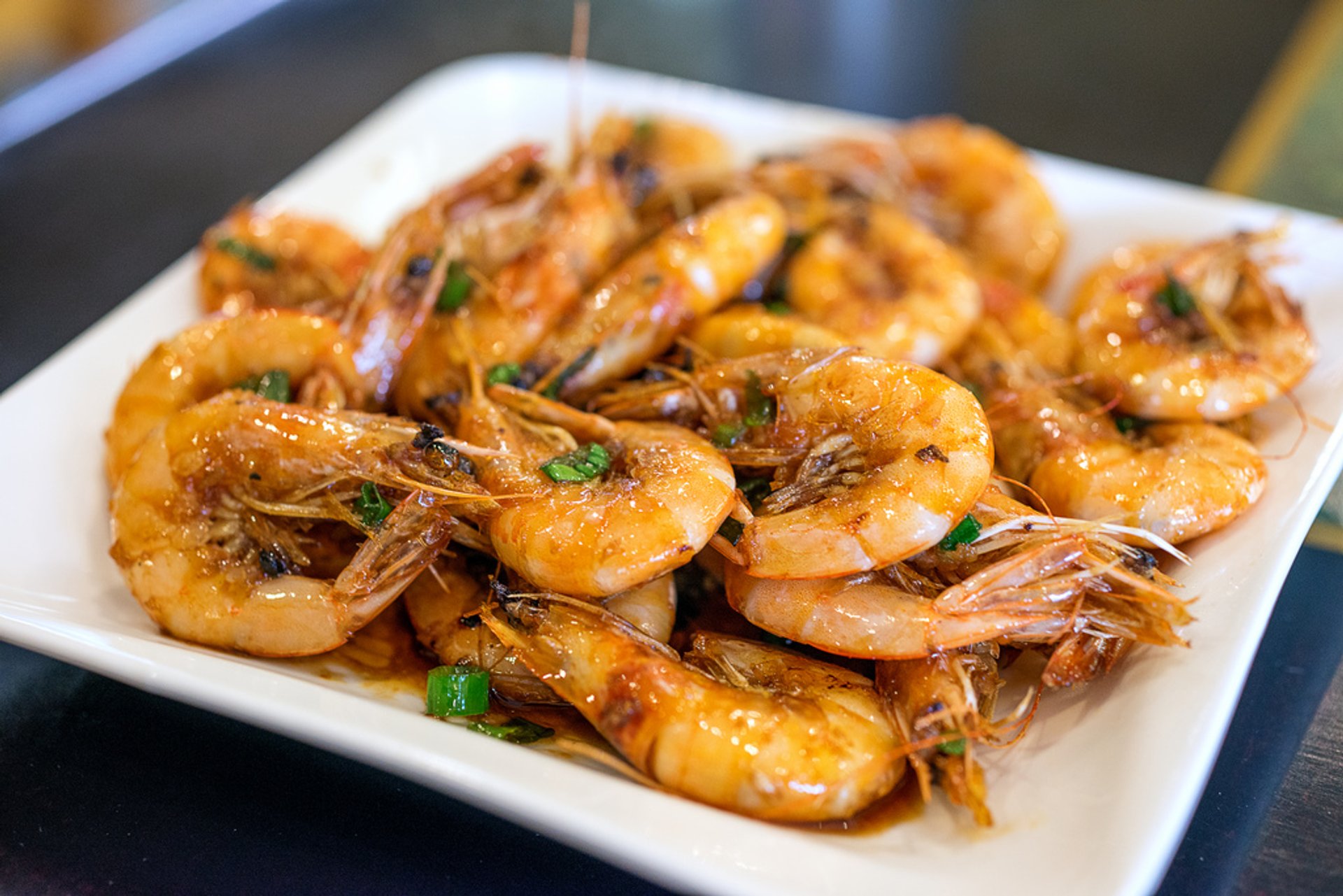
Republish this article for free
All of the Texas Observer’s articles are available for free syndication for news sources under the following conditions:
- Articles must include a link to the original and give credit in the following way at the beginning of the story:
- This article was first published by the Texas Observer, a non-profit news organization that does investigative reporting. Sign up for their newsletter once a week or follow them on Twitter and Facebook. ”.
- Articles must have the Texas Observer next to the author’s name (first name, last name, Texas Observer).
- Articles can’t be rewritten, edited, or changed in any way that doesn’t match the style guides. Partners must notify [email protected] to make style changes.
- Photos, drawings, and other kinds of art may be available for sharing, but this needs to be confirmed.
- Any advertising or social media work your news organization does must include citations for the Observer and our reporter. The Observer must also be tagged in all social media posts by the outlets.
- If the article is going to be published somewhere else, please let us know by email at [email protected].
Above: Minh Dang repairs nets on the Johnny II shrimp boat in Galveston, Texas.
Texas’s coastal roads are mostly flat, but there are some bridges that rise above many marshes, bayous, and rivers. These rivers flow into Gulf of Mexico ports that have a long history of shrimp fishing. Port Arthur and Sabine, Galveston and Bolivar, Palacios, and Port Isabel and Brownsville are home to about 95% of Texas’ shrimp fleet.
At the docks in Galveston, shrimp boats’ names reflect their owners’ hope, family, and pride. The Lucky Star promises productive trawling. The Lady Bre expresses the love of Captain Adrian Etie for his wife, Briana. The Capt. Johnny and the Capt. Johnny II and III honor owner Johnny Huyn.
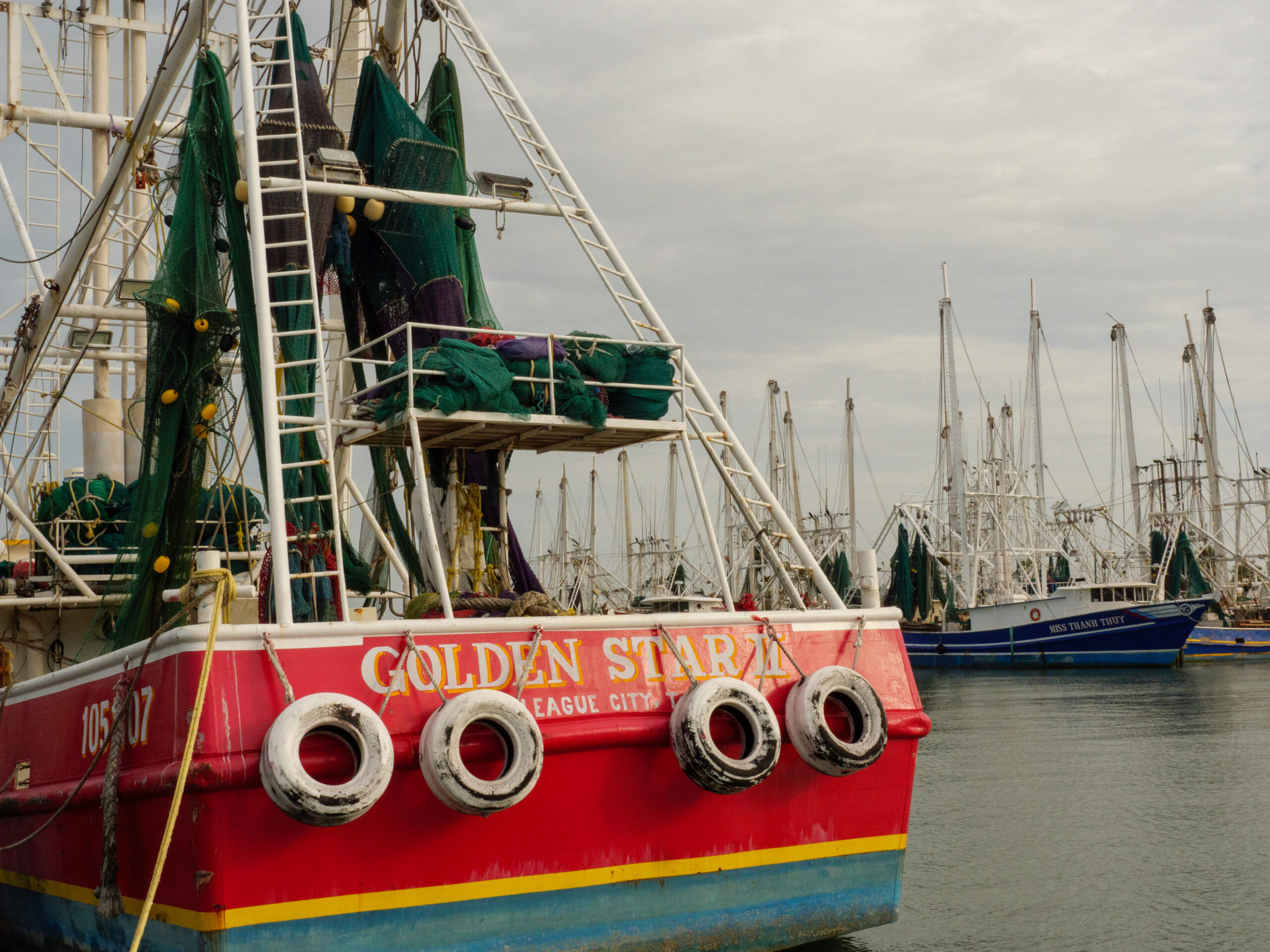
Many of these boats were not being used during the busy shrimp season, which started July 16 and ends November 30. This makes their names easy to read. Most of the time, these boats would be out at sea for weeks or in a bay for the day, following shrimp from Texas to Florida and back again. But these are not normal times. From the Gulf of Mexico around Florida to the South Atlantic, the American shrimping industry is almost completely shut down because of a flood of cheap farm-raised shrimp from Asia and South America that have been “dumped,” or sold to the US at less than market value.
There are a lot of boat owners who don’t want to spend money on diesel, repairs, and crew wages to catch shrimp that they will not be able to sell. Because prices are so low, the Eties have been going into credit card debt and using shrimp that are meant to be eaten as bait. “[Shrimpers] need supplies like ice and diesel. It takes money to get the boat out there,” said Briana Etie. “What’s the point if you can’t sell your shrimp when you get back inside?”
Minh Dang, a crew member on the Capt. Johnny II, emigrated from Vietnam fifteen years ago and worked steadily in the shrimp industry until this year. He makes money by getting a cut of the shrimp that are sold, so his family has had less trouble with his trips to sea. “I’ve had to borrow money from friends to pay my mortgage,” he said. “And my wife, who’s never worked before, has had to get a job. ”.
Five coastal counties in Texas—Galveston, Matagorda, Calhoun, Chambers, and Jefferson—have officially declared or resolved a shrimp disaster, the first time in the 100-year history of the shrimp industry. They are publicly pleading for help. Counties and parishes in the seven other southern shrimping states have also declared shrimp disasters.
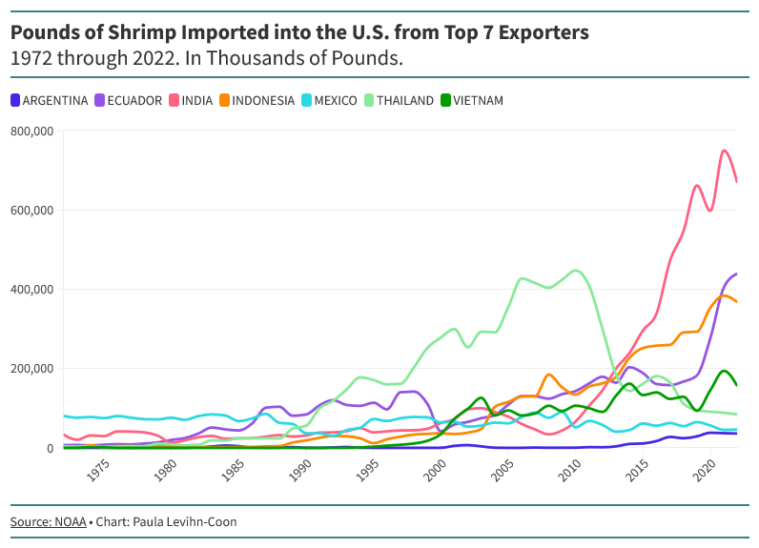
The Southern Shrimp Alliance, which is based in Florida and is the main lobbying group for the industry, has asked southern governors and members of Congress for help. “The U. S. The shrimp fishery in the Gulf of Mexico and Southeast is going through a disaster on a scale that has never been seen before. This is putting at risk both the fishery itself and the small family-owned businesses that are the backbone of the economies of coastal communities across the region. ”.

This year’s crisis arose from a longer slump. Nationwide, shrimp consumption is booming, but Americans no longer eat as many Gulf shrimp.
In 1985, Americans ate 2 pounds of shrimp per person and 90 percent of that shrimp was caught in the United States. By 2021, Americans were consuming nearly three times as many shrimp—an average of 5.9 pounds per person per year, according to the National Fisheries Institute. But 94 percent of that shrimp is imported.
In 2022, the United States imported more shrimp than Americans eat. Both imported and domestic shrimp have piled up in freezers at shrimp processors. “They literally have nowhere to store it or sell it. Cold storage is full across the Gulf. “I’ve heard that there are freezer trucks in some Florida cold storage parking lots,” said Laura Picariello, a marine fisheries expert at Texas A&M University. “[Shrimpers] are really struggling. If things don’t change, some people will not be in this business at all by the end of the year. I’m not sure how things are going to change at this point. ”.
Prices have plummeted. The National Oceanic and Atmospheric Administration’s latest data (from May) showed shrimp prices for three sizes of shrimp were at their lowest since 2002, and since then, they’ve plunged more.
The Texas shrimp fishery remains the state’s largest commercial fishery, accounting for over 80 percent of commercial fish landings. In an average year, Texas shrimpers and shrimp processors contribute about $320 million to the Texas economy and employ over 5,000 full- and part-time workers, according to Texas A&M.
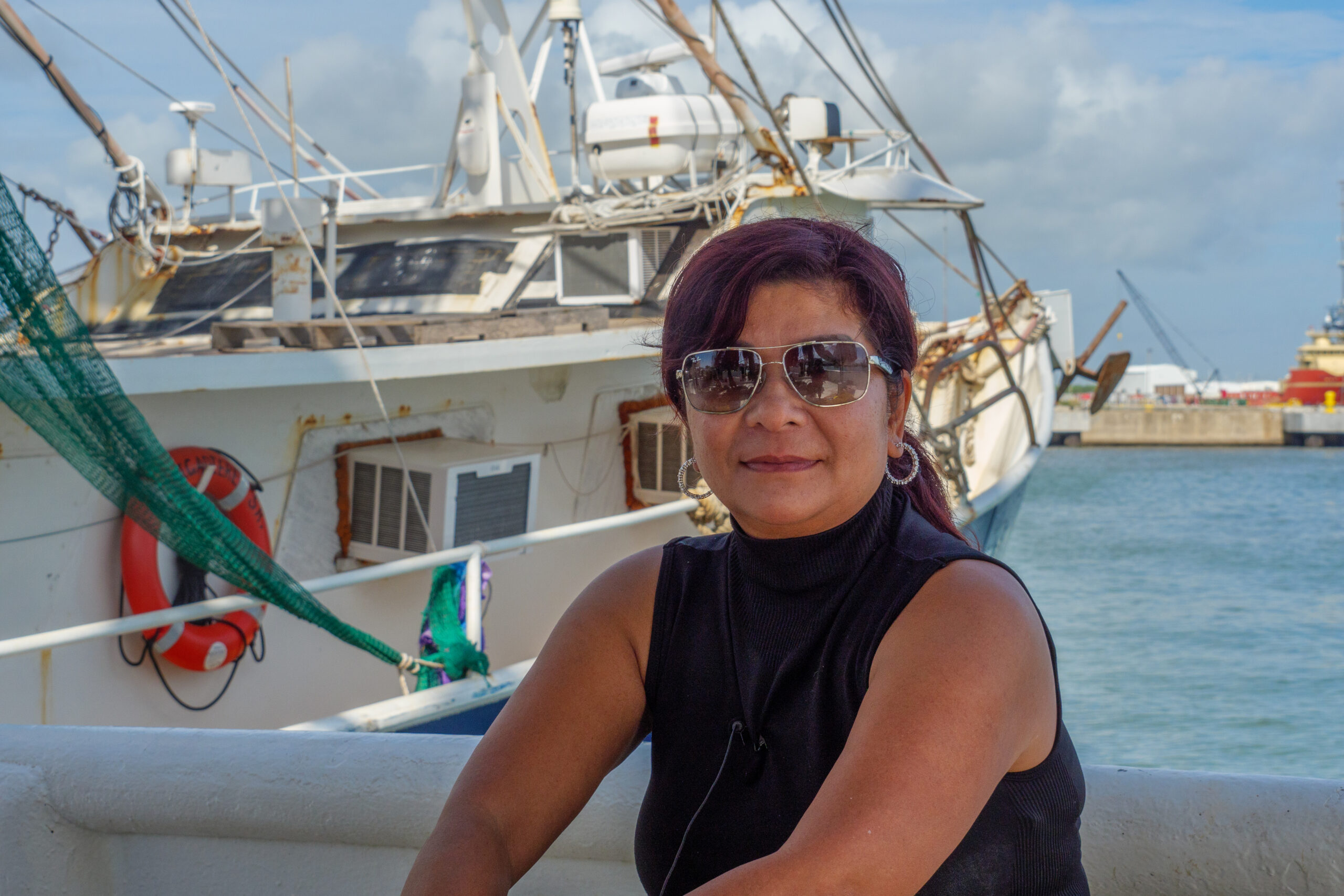
A third of the shrimpers in Texas are Vietnamese, another third are white, and the last third are Hispanic. The Vietnamese fleet is mostly on the north coast of Texas, while the Hispanic fleet is mostly on the south coast. Palacios is the port where all these cultures meet. “Palacios is a really great mix of all three, and they all work really well together,” Picariello said. “It’s a really cool place. ”.
But this year, shrimpers in Palacios and elsewhere are asking Picariello how to apply for food stamps. Another priest in Port Arthur, Father Sinclair Oubre, is worried about the mental health and suicide risk of shrimpers. He is the treasurer of the Port Arthur Area Shrimpers Association.
Shrimpers blame the federal government for the current shrimp crisis. The husband of the Galveston shrimper said, “I just don’t understand why the government doesn’t want to help control [shrimp imports] and help our own American companies.”
Since the 1970s, international monetary funds like the World Bank—which gets some of its money from the U.S.—have helped developing countries’ economies grow. S. government—supported the construction of aquaculture facilities in Asia and South America. Some of these loans were later forgiven. With those investments, cheap labor, and less strict rules on the environment, these countries were able to make shrimp that they sold to the US for a low price starting in the 1980s.
Ecuador and India are currently perceived as the largest threats to the U.S. shrimp industry. In five years, from 2016 through 2022, the volume of shrimp imported from these two countries skyrocketed to 59.8 percent from 37.5 percent of U.S. shrimp imports, according to trade data.
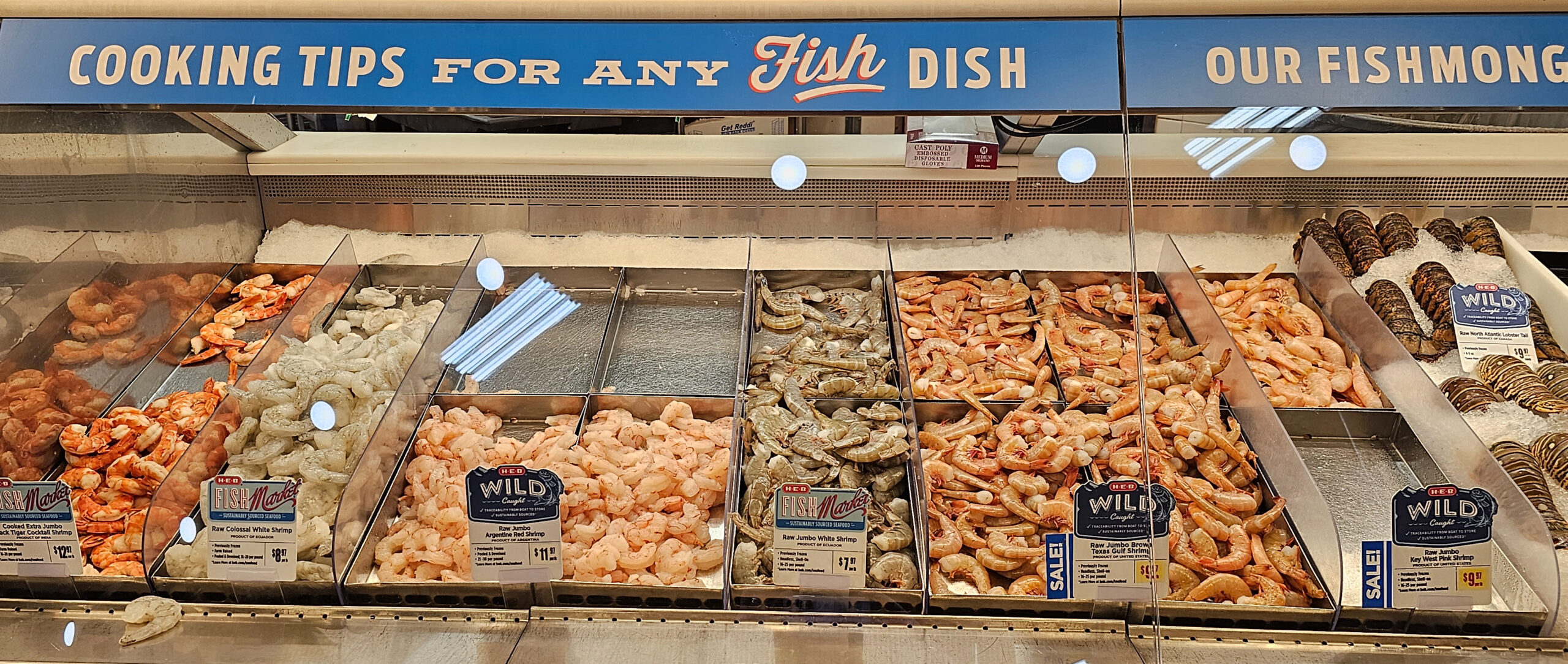
“The World Bank is financing the Ecuadorian shrimp and they’re using our tax dollars to do it. They’re making it tough,” said Luke Rawlings, who owns shrimp boats and a bait camp in Matagorda. He was driving a trailer full of frozen shrimp to New Mexico to sell his catch directly to restaurants when the Texas Observer called him.
Ecuador grew its shrimp industry to fulfill demand from China. During the pandemic, however, China stopped importing shrimp from Ecuador. With nowhere to export its shrimp, Ecuador sent it to the United States. China has since resumed its imports, but Ecuador is not stopping exports stateside. Its worldwide exports have grown 15 percent since last year, to 2.34 billion pounds. Ecuador is currently the world’s largest shrimp exporter, according to Intrafish.
Shrimp farms in India are heavily subsidized. For example, in 2017, shrimp farmers in Punjab received a 90 percent subsidy to dig shrimp ponds and a 50 percent subsidy for purchasing equipment and feed.
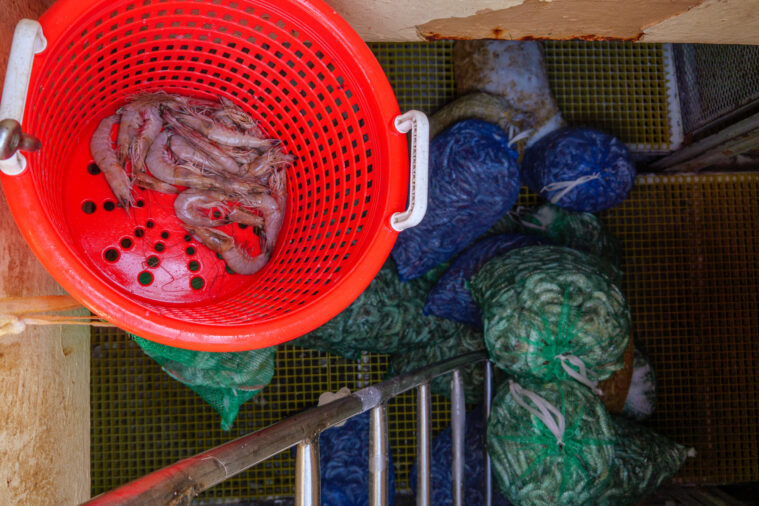
American shrimpers, in contrast, do not receive financial help from the government. “It’s not like farming. There are no subsidies. “Men who fish won’t get any money,” said Nikki Fitzgerald with Texas A&M.
Besides the financial harm caused to American shrimpers, there are environmental and ethical concerns about importing farm-raised shrimp. These include the use of forced labor in shrimp aquaculture and processing; deforestation of coastal mangrove swamps—which are nurseries for aquatic animals and protect coastal lands from erosion—to make aquaculture ponds; and the chemicals and antibiotics found in imported shrimp.
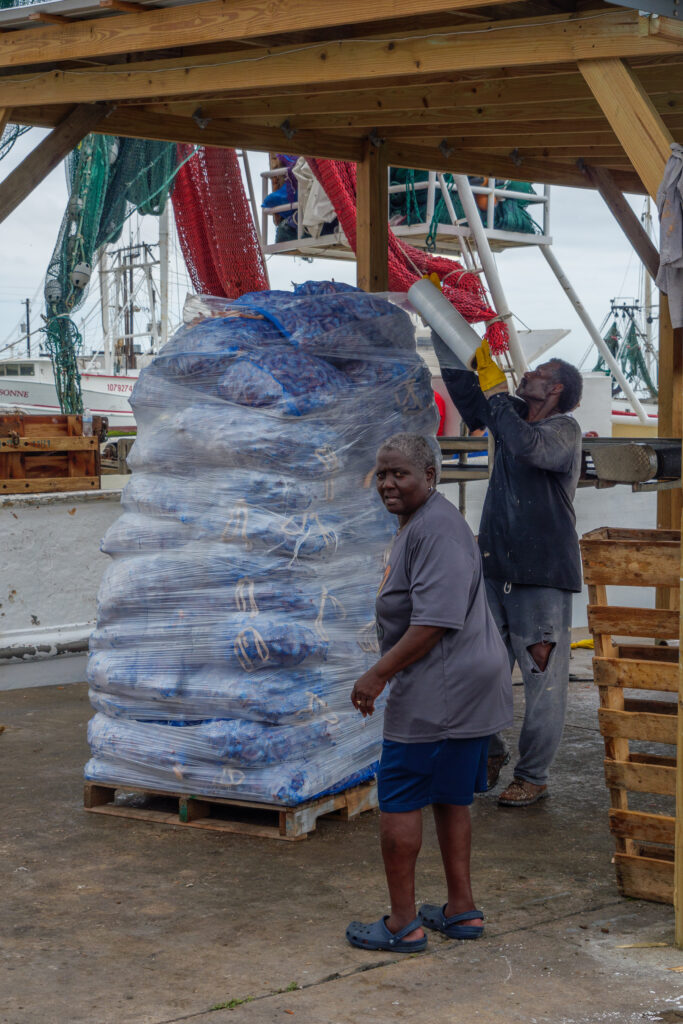
A 2015 Consumer Reports investigation, “How Safe is Your Shrimp?”, found that 61 percent of the shrimp they tested from Ecuador and 74 percent from India contained dangerous bacteria, antibiotics and drug residues. It also noted that the Federal Drug Administration only tests 0.7 percent of imported shrimp.
In contrast, the European Union, Canada, and Japan test between 15 and 50 percent of their imported seafood, according to the Johns Hopkins Bloomberg School of Public Health.
In Texas, bay shrimpers usually go out for the day and catch bait shrimp all year and shrimp to eat in the fall and spring. They keep their catch on ice or in live wells.
A lot of Gulf shrimpers stay out at sea for weeks at a time, only coming back to port to fix things or get more fuel. Shrimp are individually quick-frozen and sorted by size at sea. But shrimpers haven’t gone far in the last two years because boat owners can’t afford the diesel that goes with it. “This has been a very big disruption Gulf-wide in how this fleet operates,” Picariello said.
Regular maintenance is done on boats when the season is over, but these days, “a lot of these people don’t want to put any more into their boats,” said Nga Pham, a dock owner who has worked in the shrimp business her whole life. She said that a lot of shrimpers have dropped their insurance, which is a risk at any time but especially during hurricane season.
There isn’t much hope that things will get better quickly enough to save Texas shrimpers this shrimp season, but things are moving in the right direction. On September 28, U. S. Senator Bill Cassidy, R-L. A. passed the India Shrimp Tariff Act, which would make it more expensive for Americans to buy shrimp from India by as much as 40% by 2024. On October 25, a coalition of shrimp organizations petitioned the U. S. International Trade Commission to impose tariffs on shrimp from Vietnam, Ecuador, India, and Indonesia.
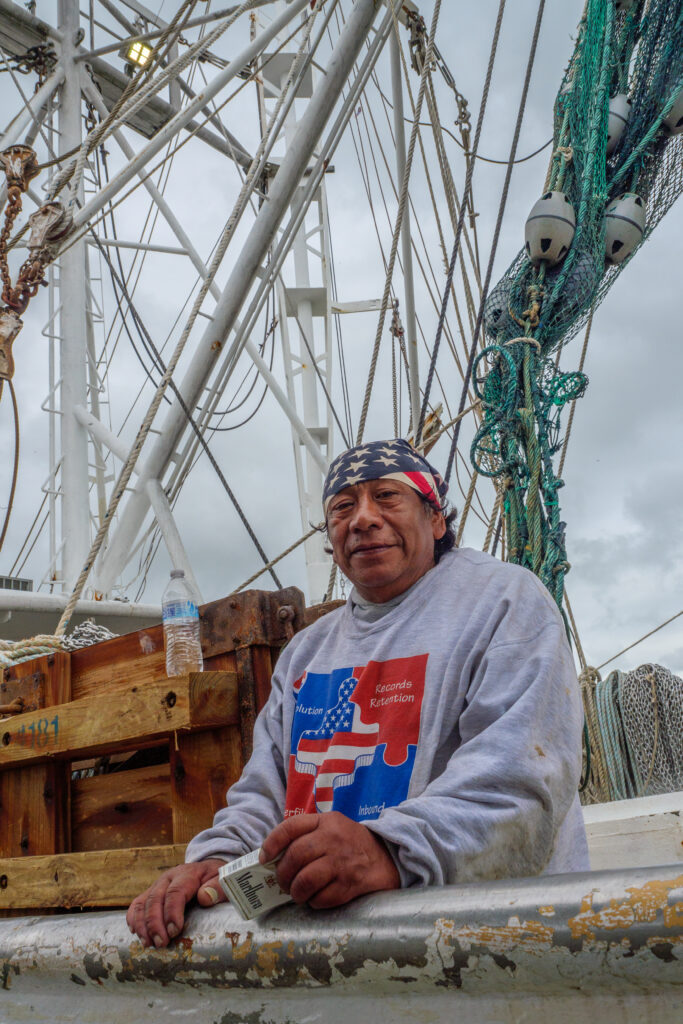
Deborah Long of the Southern Shrimp Alliance said that other efforts, such as getting the US Department of Agriculture to buy American shrimp for government facilities like prisons and military bases; testing imported shrimp more; banning countries that use slave labor; and putting in place new tariffs, could help the industry fairly quickly. But it takes a lot longer for international trade talks to produce results.
Long said, “Having a domestic [shrimp] industry is vital when you look at the environment, health, national security, and the general food supply.” ‘“But more importantly, [shrimping] is a huge economic driver in coastal communities. They are not just the boat and the crew. They are the icehouse and the dock and the trucks that are moving the shrimp. There are entire communities that are at risk if this industry goes under. ”.
Some boat owners keep sending their boats out to sea, even after paying for repairs, fuel, and the wages of their skilled crew, just to keep them from taking jobs on land. Long said, “Once an owner loses his crew, it’s very difficult to find somebody who is willing and capable to go out to sea for several weeks and run the boat the way it needs to be run.”
Ken Garcia meets Captain Oscar Narahao and the crew of the Father Mike when they arrive at the Palacios docks. The boat is named after a Catholic priest cousin of his father. As he watches as bags of shrimp are taken from the hold and put on pallets, he thinks about this shrimp season. “It’s been pretty tough, pretty bad. A lot of imports,” he said. “Our own government let us down. ”.
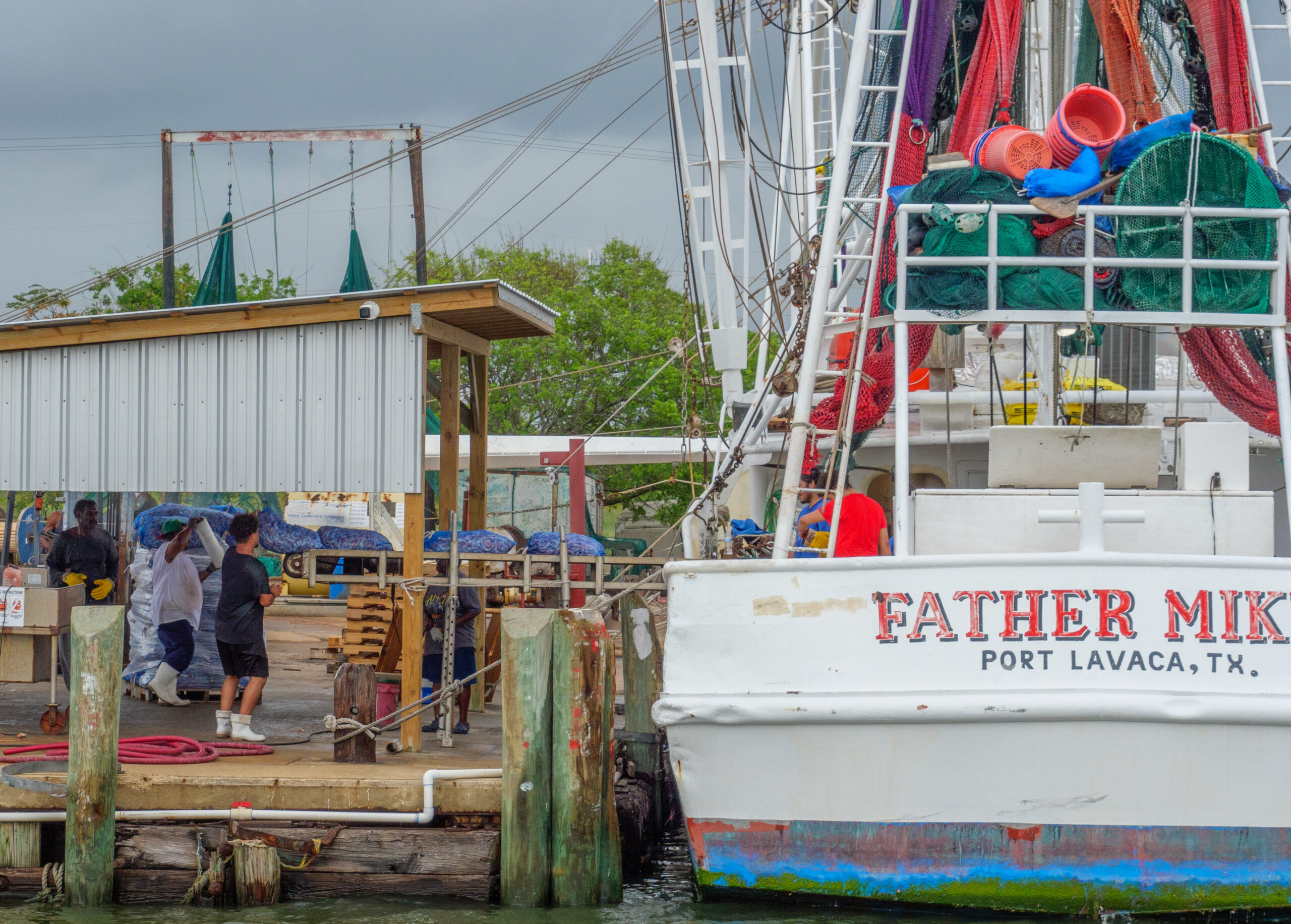
Garcia’s grandfather, Edward Garcia Sr. , started his family’s shrimp business in 1952. Garcia and his father now own 15 shrimp boats, one of the largest shrimp fleets in Texas. Even though shrimp prices are low, they have been at sea for 50 days at a time this season, but not as many times as usual.
“It wasn’t profitable for us to work, and there’s only so much bleeding we can do,” Garcia said. “I had a lot of families to worry about, people counting on me, so we had to try. About half of my employees have been with me for 15 years, and many of them worked for my dad for 15 years before that. So, you know, I owe it to them. “They bought a lot of shrimp in this weak market,” which is why he was able to send boats out to sea. H-E-B is his biggest customer. ”.
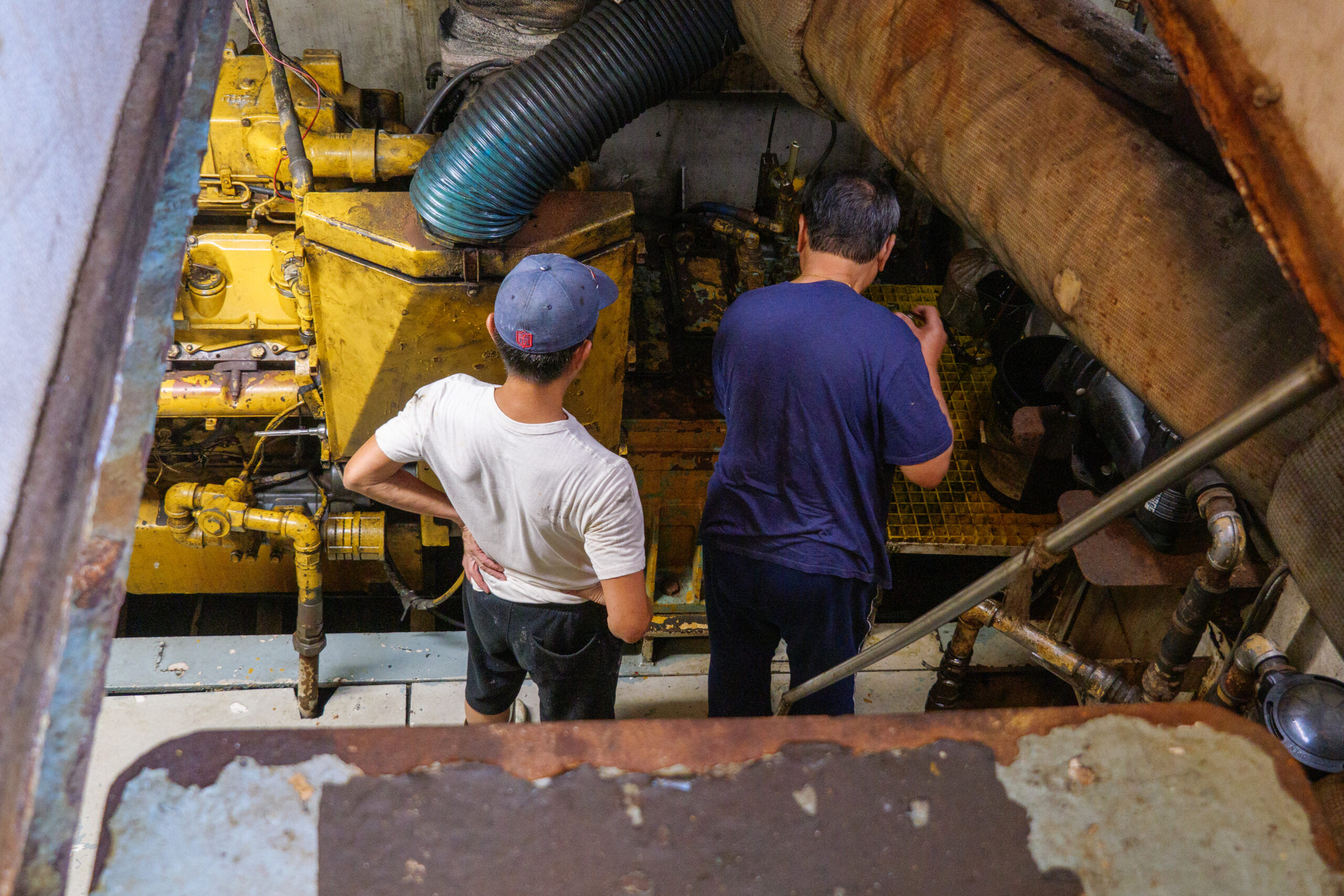
At the end of the season, he plans to tie up his fleet. He doesn’t know if or when he will send boats back out to sea. Five years ago, his crews made about 80% of what the captains made, which was 35% of the value of the shrimp they caught. The captains made $80,000 to $100,000 a year. “This year, they all made about half of that,” Garcia said. “They’re working twice as hard for the same money. ”.
The Observer asked Garcia if he wanted his one-year-old son to become a shrimper one day. “I don’t know. “Maybe three generations is enough,” he said. “I was lucky enough to get to do what my dad and grandpa did.” “Maybe he should do something else. ”.
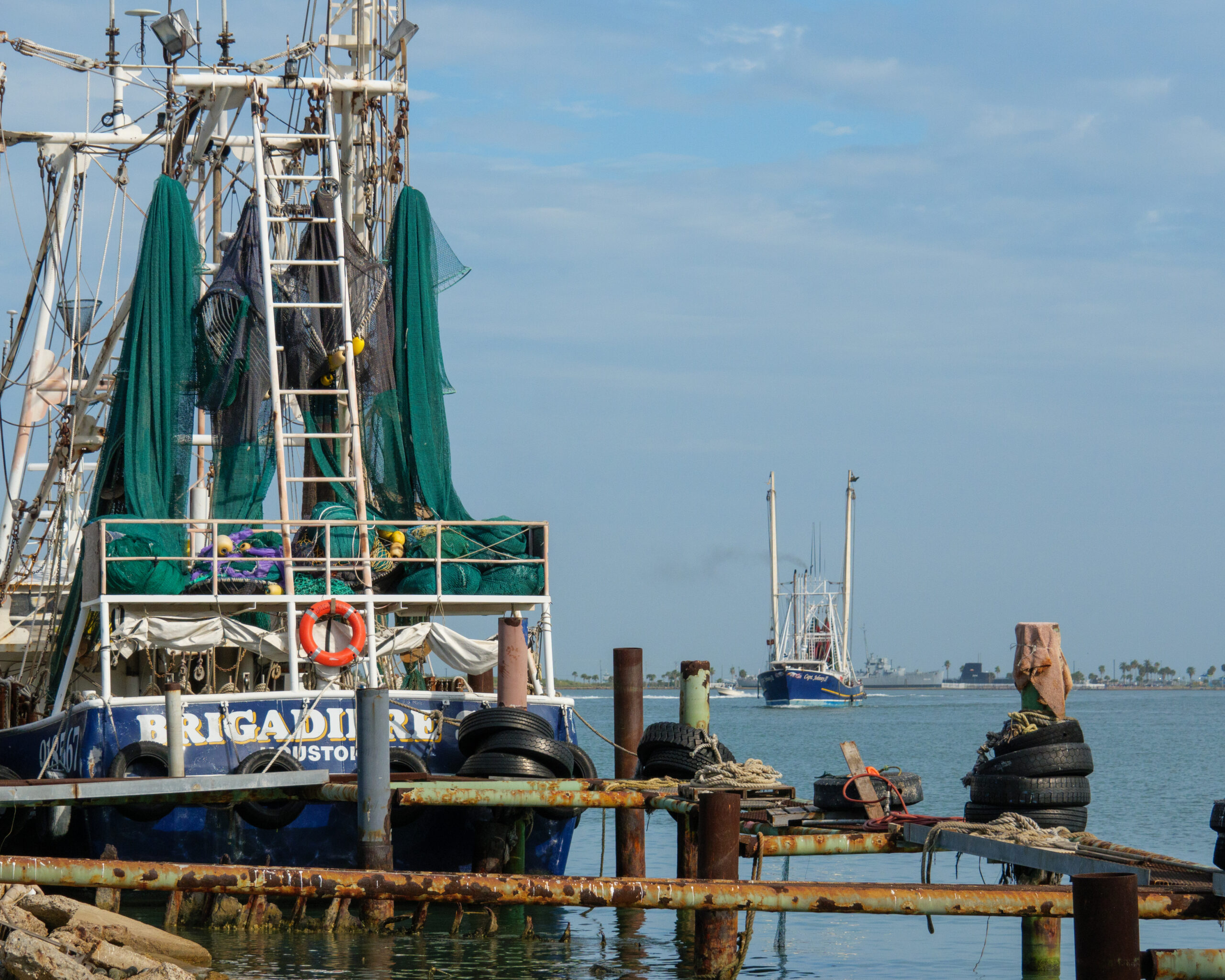
Correction: Nikki Fitzgerald was not listed as a signatory on the Chambers County shrimp disaster declaration in an earlier version of this story. The Observer apologizes for the error.
